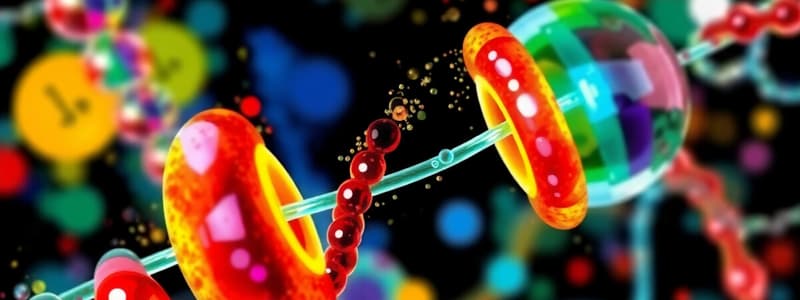Podcast
Questions and Answers
What molecule is known as the primary energy currency of the cell?
What molecule is known as the primary energy currency of the cell?
- NADH
- ADP
- Glucose
- ATP (correct)
The last phosphate group of ATP contains the least amount of energy.
The last phosphate group of ATP contains the least amount of energy.
False (B)
Which process involves the conversion of ADP and inorganic phosphate into ATP?
Which process involves the conversion of ADP and inorganic phosphate into ATP?
dehydration
Energy-rich molecules are metabolized by a series of __________ reactions.
Energy-rich molecules are metabolized by a series of __________ reactions.
Match the component of ATP with its description:
Match the component of ATP with its description:
What type of reaction is the hydrolysis of ATP?
What type of reaction is the hydrolysis of ATP?
The constituents of the electron transport chain are primarily located in the outer mitochondrial membrane.
The constituents of the electron transport chain are primarily located in the outer mitochondrial membrane.
What is the primary function of valinomycin in mitochondria?
What is the primary function of valinomycin in mitochondria?
Leber hereditary optic neuropathy is caused by mutations in mitochondrial DNA.
Leber hereditary optic neuropathy is caused by mutations in mitochondrial DNA.
What type of ionophore is gramicidin?
What type of ionophore is gramicidin?
Inherited defects in oxidative phosphorylation are often linked to mutations in ______.
Inherited defects in oxidative phosphorylation are often linked to mutations in ______.
Match the following diseases or conditions with their causes:
Match the following diseases or conditions with their causes:
Which coenzyme is formed when NAD+ is reduced?
Which coenzyme is formed when NAD+ is reduced?
FADH2 generates more ATP than NADH during oxidation.
FADH2 generates more ATP than NADH during oxidation.
What is the main function of ATP synthase in the mitochondria?
What is the main function of ATP synthase in the mitochondria?
The process of transferring electrons from coenzymes to oxygen is called _____ oxidation.
The process of transferring electrons from coenzymes to oxygen is called _____ oxidation.
Match the following terms with their descriptions:
Match the following terms with their descriptions:
What role does oxygen play in the electron transport chain?
What role does oxygen play in the electron transport chain?
The primary purpose of ATP synthesis is to generate heat.
The primary purpose of ATP synthesis is to generate heat.
What is produced when protons are pumped from the mitochondrial matrix to the intermembrane space?
What is produced when protons are pumped from the mitochondrial matrix to the intermembrane space?
The classic example of an uncoupler is _____ obtained from toxic substances.
The classic example of an uncoupler is _____ obtained from toxic substances.
What is released as a result of uncouplers acting in the mitochondria?
What is released as a result of uncouplers acting in the mitochondria?
Flashcards are hidden until you start studying
Study Notes
Cellular Energy
- ATP contains adenosine, ribose and three phosphate groups
- The last phosphate group contains the most energy
- Each cell generates and consumes approximately 10,000,000 ATP molecules per second
Coupled Reaction - ATP
- Exergonic hydrolysis of ATP is coupled with endergonic dehydration
- A phosphate group from ATP is transferred to another molecule
Hydrolysis of ATP
- ATP + H2O --> ADP + P (exergonic)
- Water is added to ATP
- Adenosine Triphosphate (ATP) becomes Adenosine Diphosphate (ADP)
Dehydration of ATP
- ADP + P --> ATP + H2O (endergonic)
- Water is removed
- Adenosine Diphosphate (ADP) becomes Adenosine Triphosphate (ATP)
Electron Transport Chain
- Located in the inner mitochondrial membrane
- Glucose is metabolized by a series of oxidation reactions
- These reactions generate CO2 and water
- NAD+ and FAD are coenzymes
- NAD+ and FAD are reduced to form NADH and FADH2
- NADH and FADH2 donate electrons to the electron transport chain
- Electrons lose free energy as they pass through the electron transport chain
- Protons (H+) are pumped from the mitochondrial matrix to the intermembrane space
- This creates a concentration gradient that activates ATP synthase
- ATP synthase uses free energy from the gradient to produce ATP
- Oxygen is reduced to form water
Energetics of ATP Synthesis
- Approximately 40% of energy is trapped as ATP
- Remaining free energy is used for transport of Ca2+ into mitochondria and for generating heat
- When NADH is oxidized, approximately 3 ATP molecules are generated
- When FADH2 is oxidized, approximately 2 ATP molecules are generated
Oxidative Phosphorylation
- Oxidative phosphorylation is the coupling of oxidation and phosphorylation
- Oxidation is the transfer of electrons from reduced coenzymes to oxygen
- Phosphorylation is trapping energy in ATP
Uncouplers
- Uncouplers increase the permeability of the inner mitochondrial membrane to protons
- Classic example is 2,4-dinitrophenol, a lipophilic proton carrier
- Uncouplers cause electron transport to continue at a rapid rate without establishing a proton gradient
- Energy is released as heat
- Physiological uncouplers include bilirubin, long chain free fatty acids, and thyroxin
- Aspirin and salicylates uncouple oxidative phosphorylation in high doses
Ionophores
- Ionophores increase the permeability of lipid bilayers to certain ions
- Mobile ion carries (e.g., valinomycin) and channel formers (e.g., gramicidin) are types of ionophores
- Valinomycin allows potassium to permeate mitochondria, dissipating the proton gradient
- Calcium ions stimulate dephosphorylation
Inherited Defects in Oxidative Phosphorylation
- Mutations in mitochondrial DNA (mtDNA) are responsible for several diseases, including mitochondrial myopathies and Leber hereditary optic neuropathy
- Leber hereditary optic neuropathy (LHON) is characterized by bilateral loss of central vision due to neuroretinal degeneration, including damage to the optic nerve
- The primary LHON mutation decreases cellular respiration and mitochondrial complex I specific activity
Studying That Suits You
Use AI to generate personalized quizzes and flashcards to suit your learning preferences.



